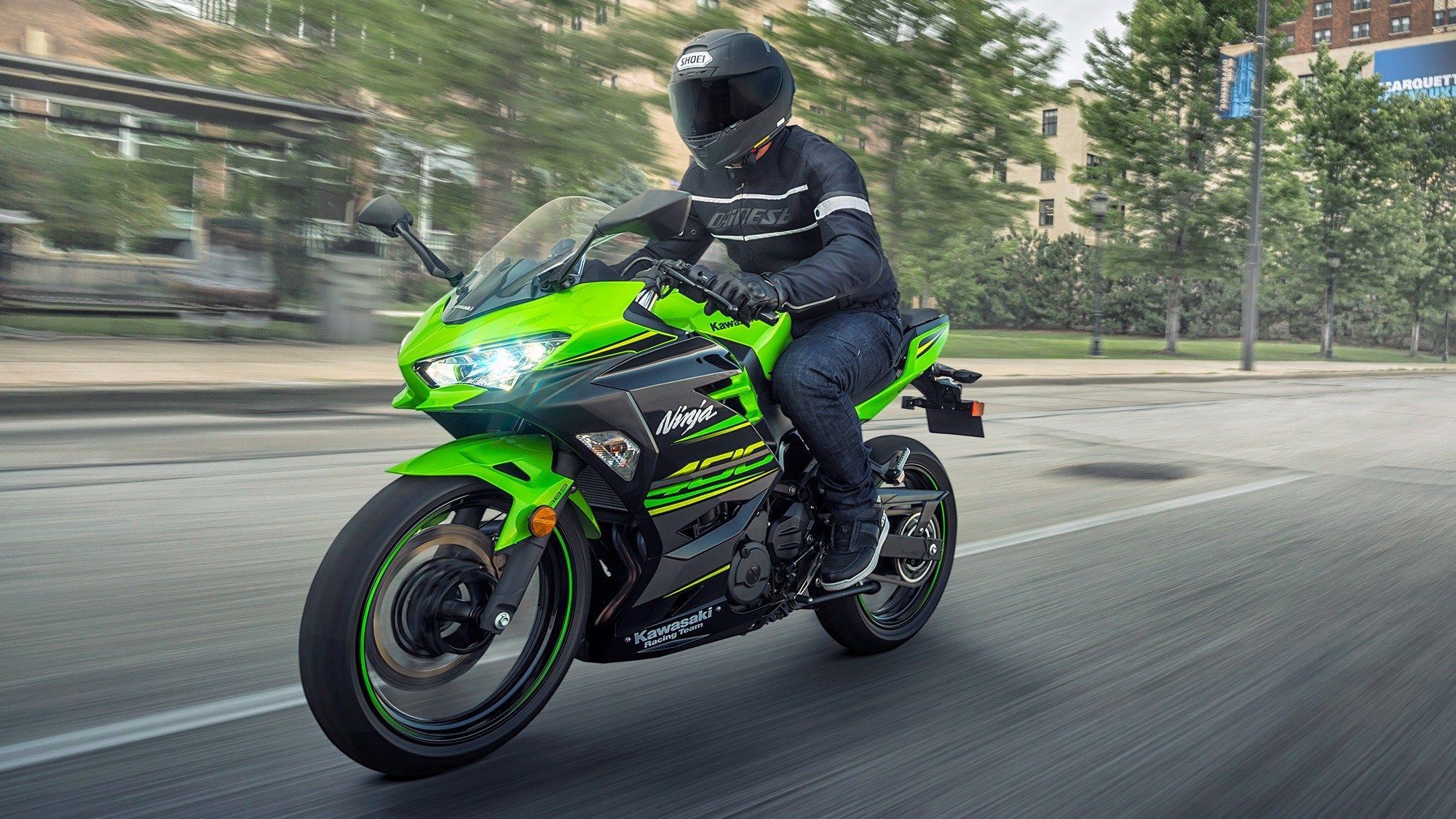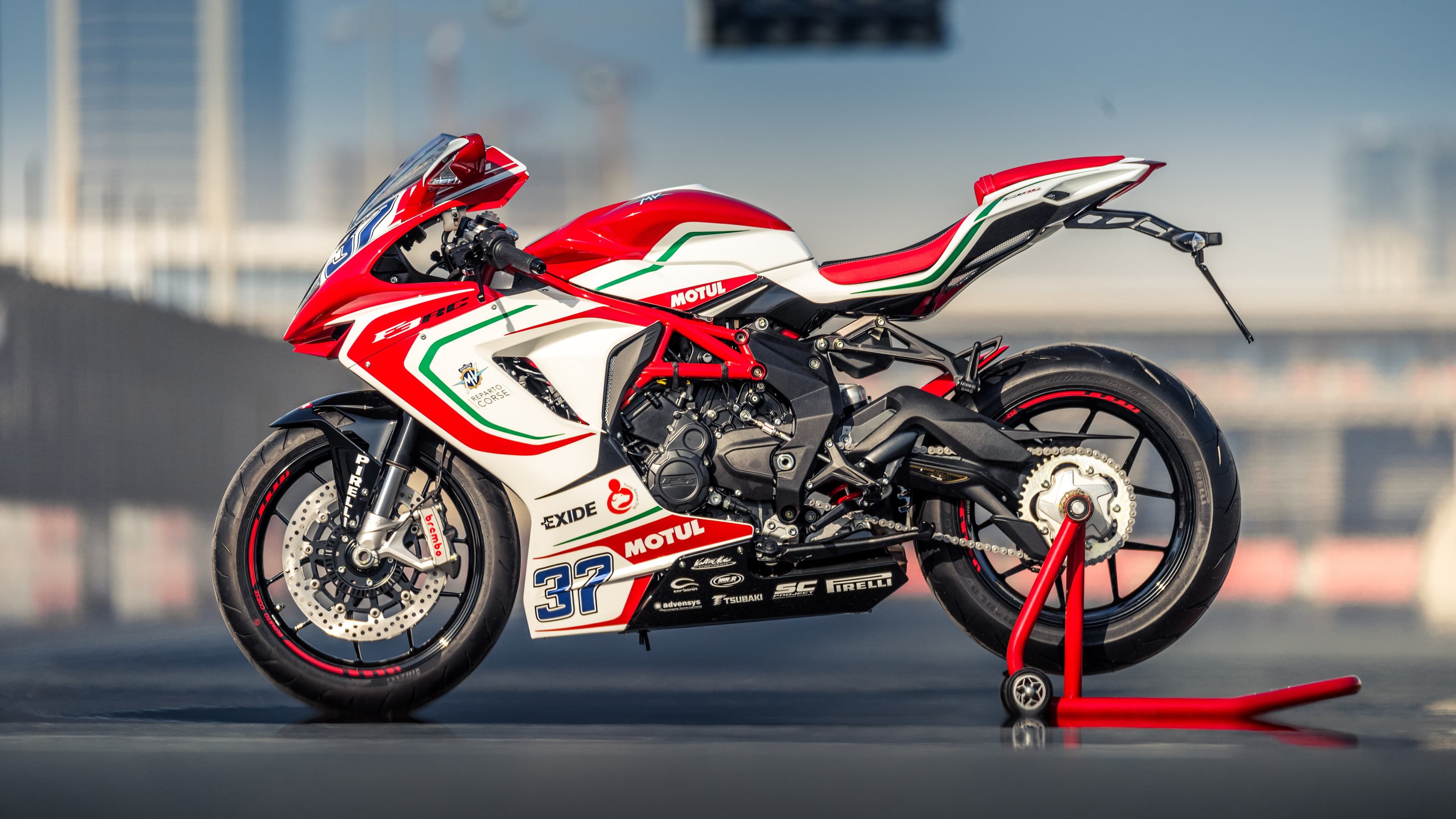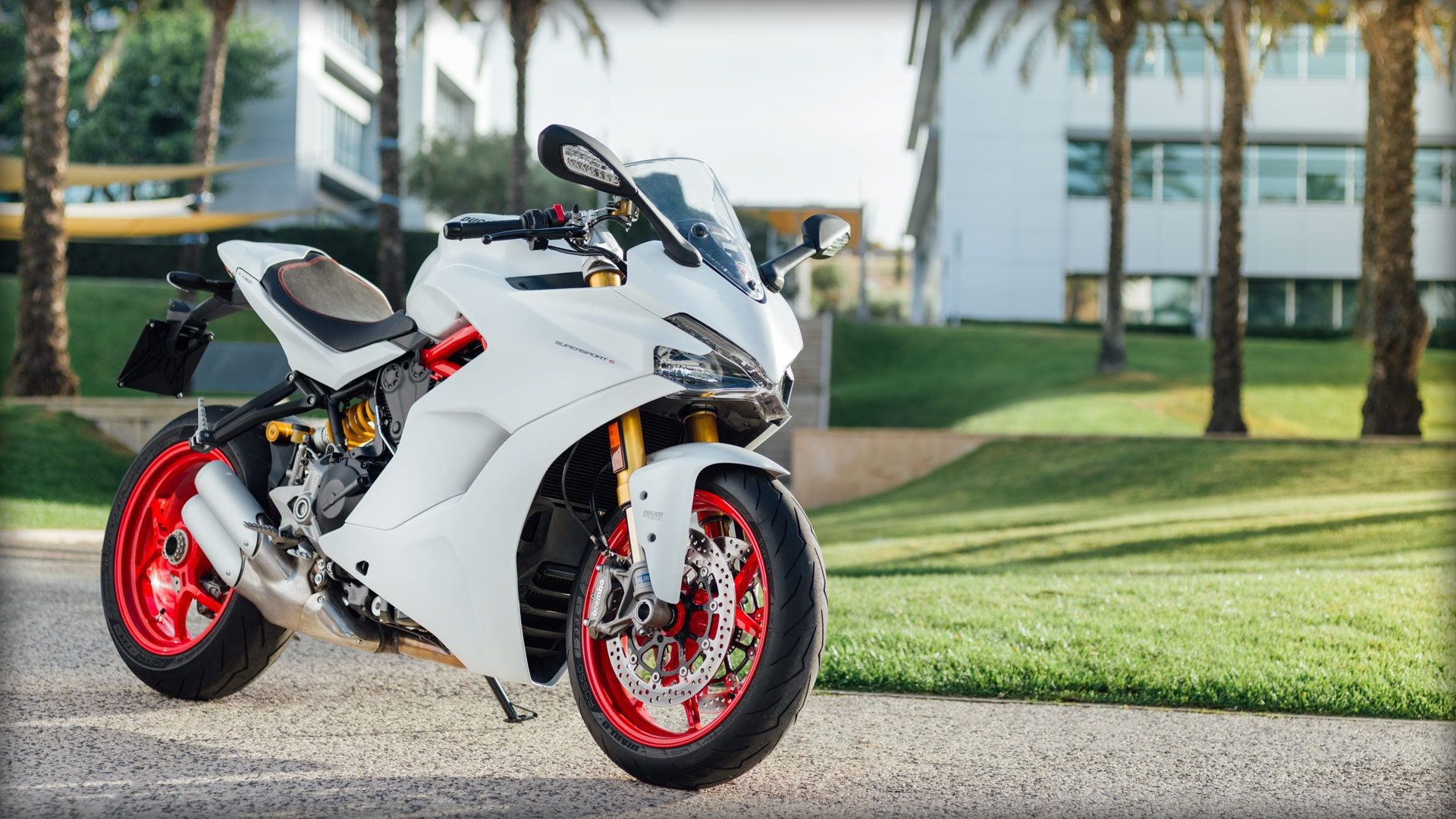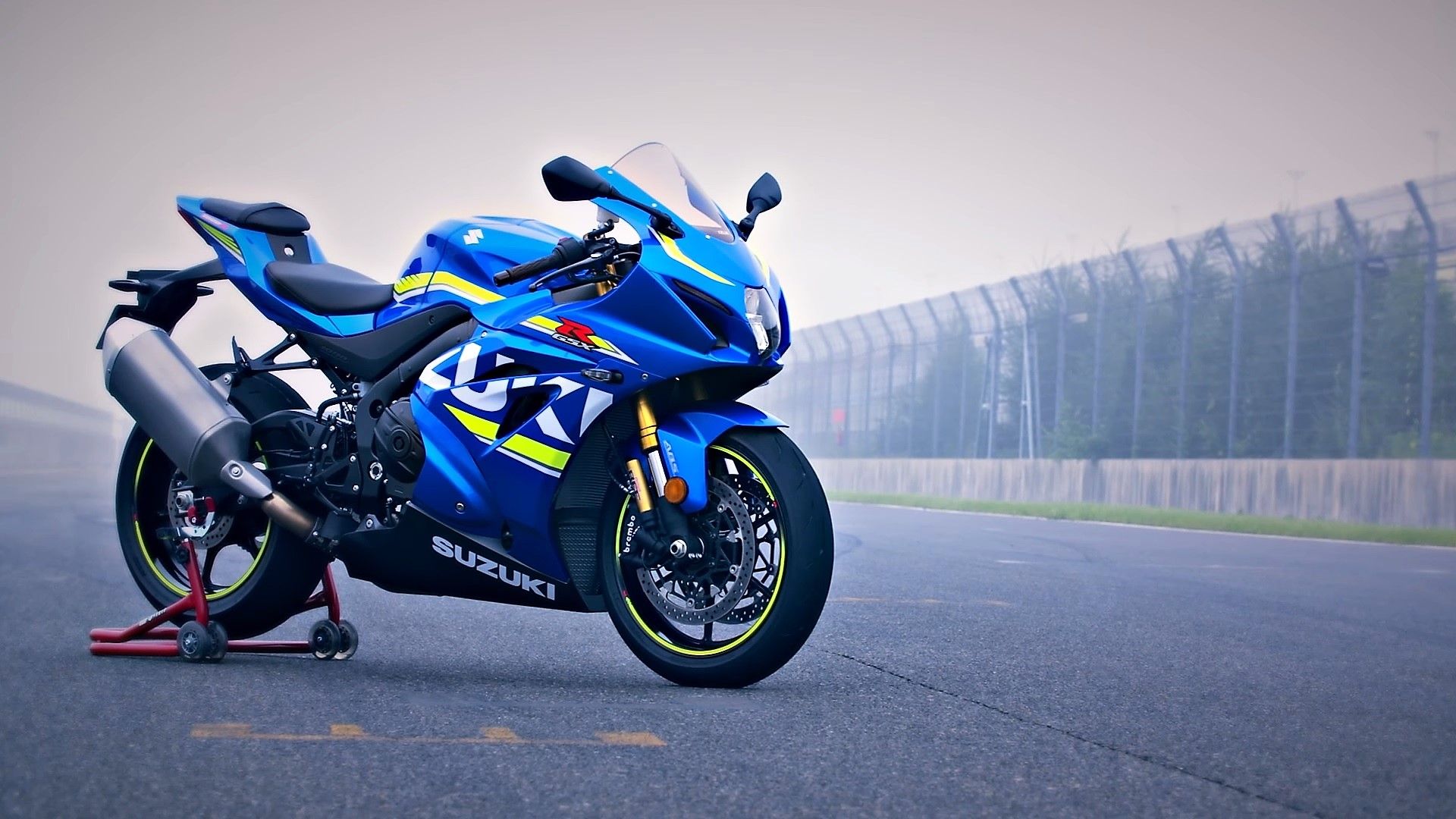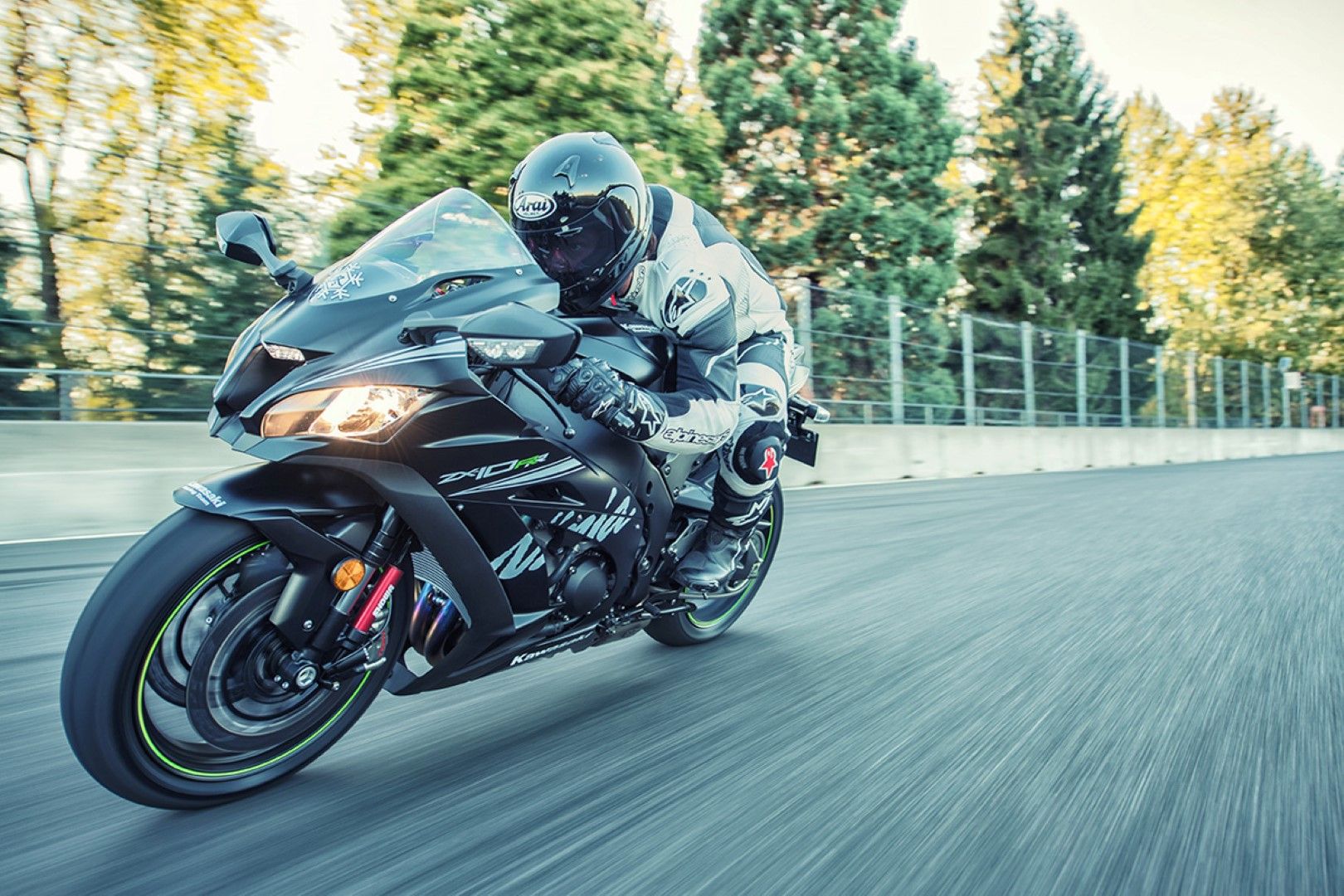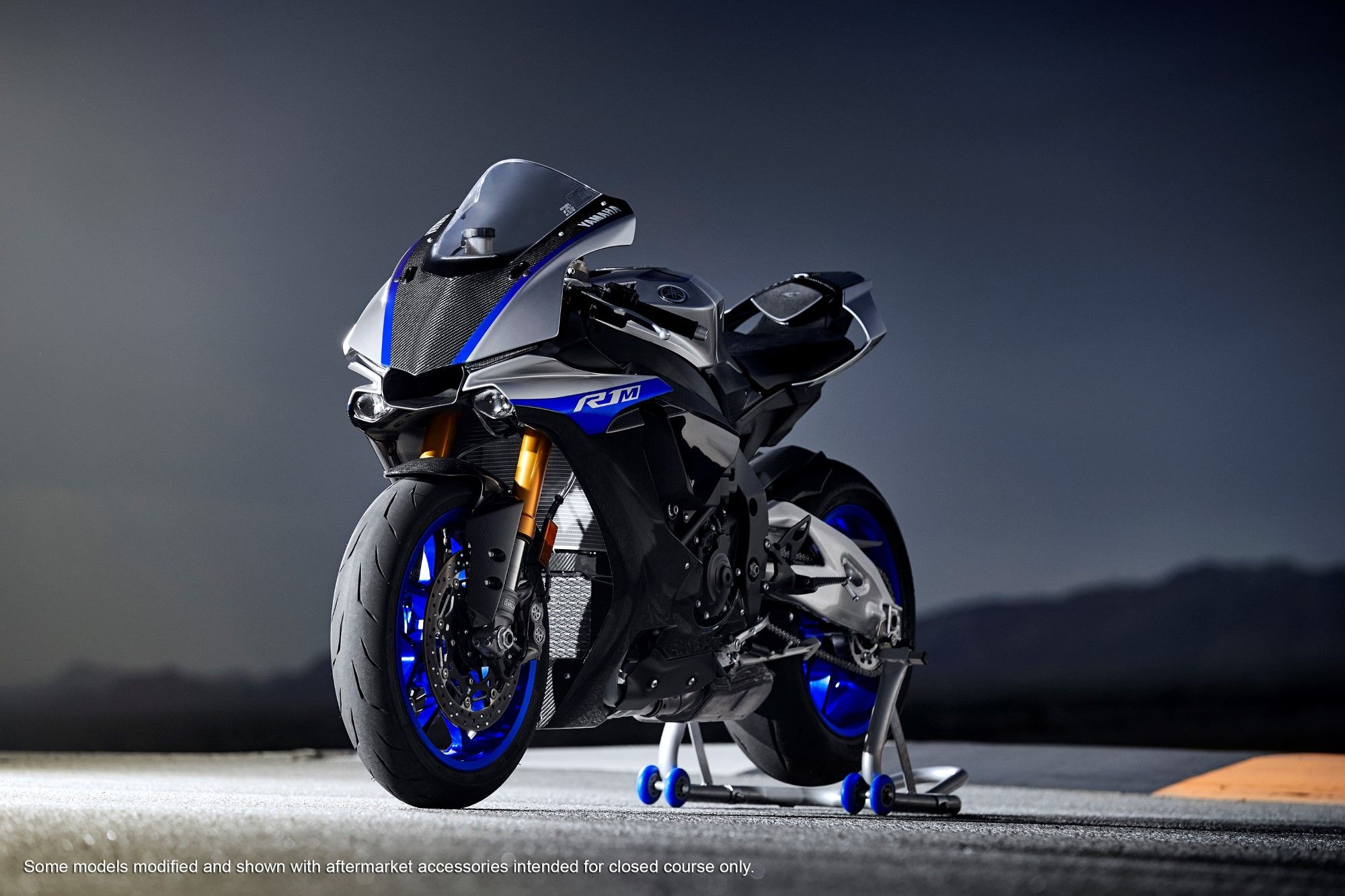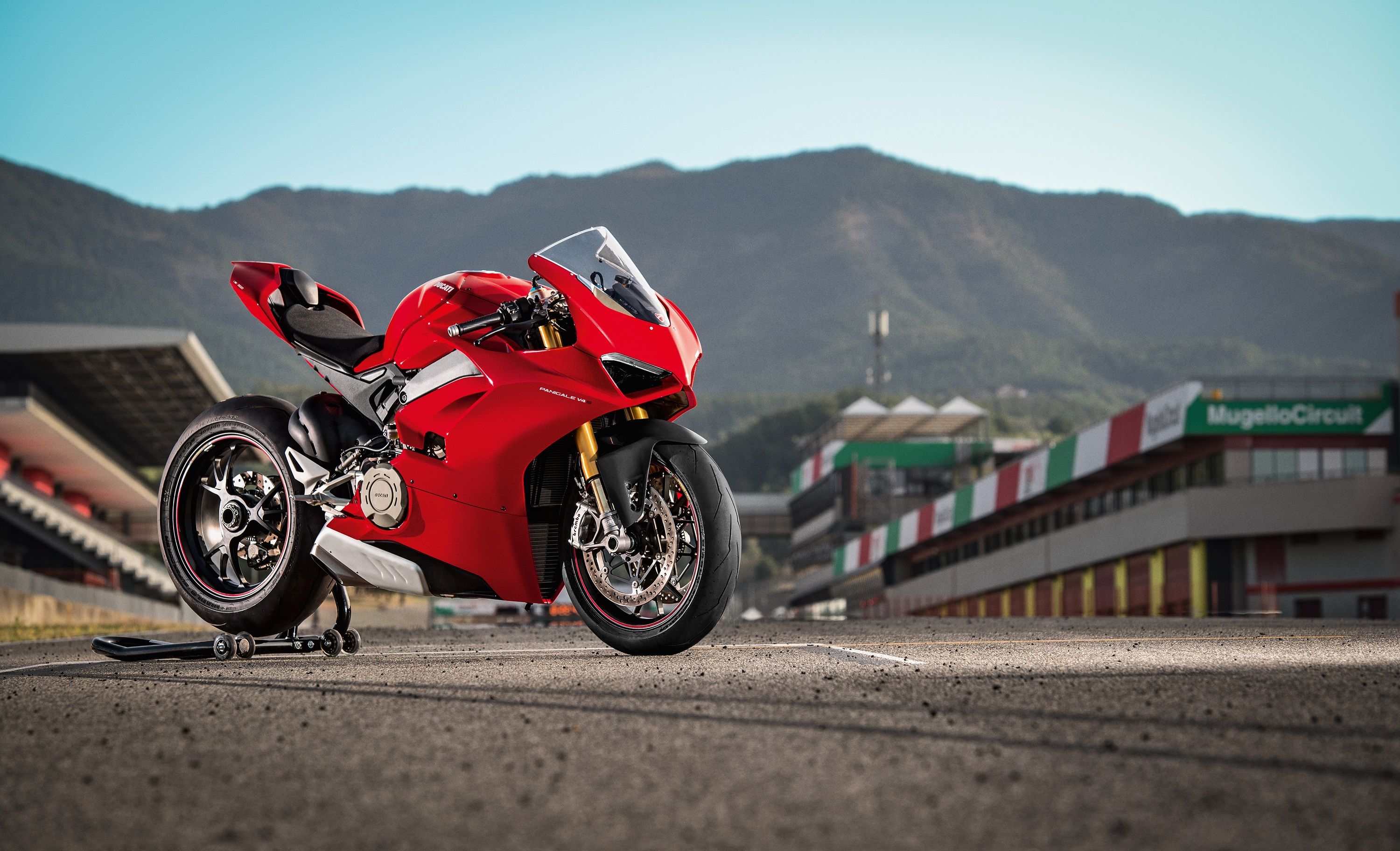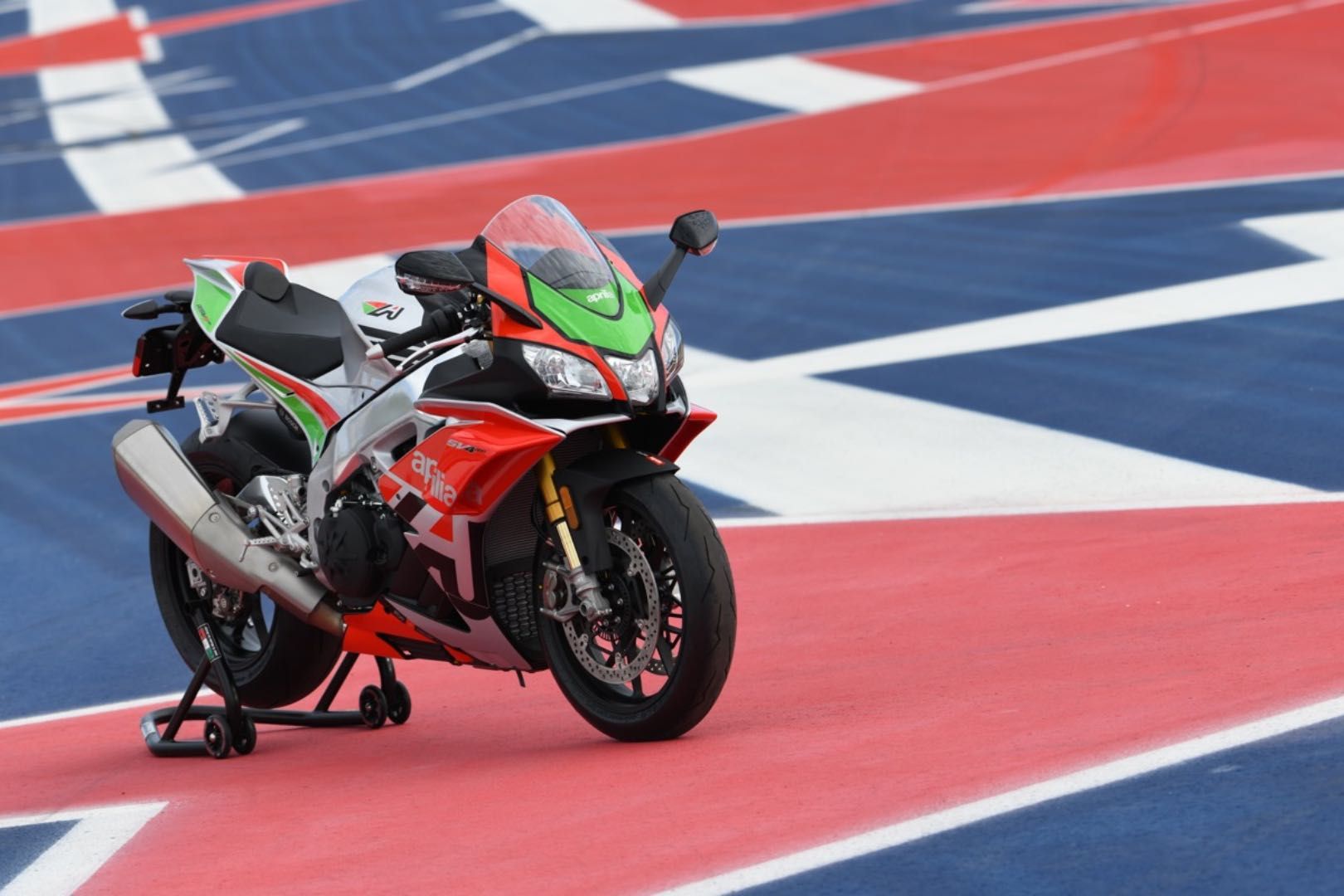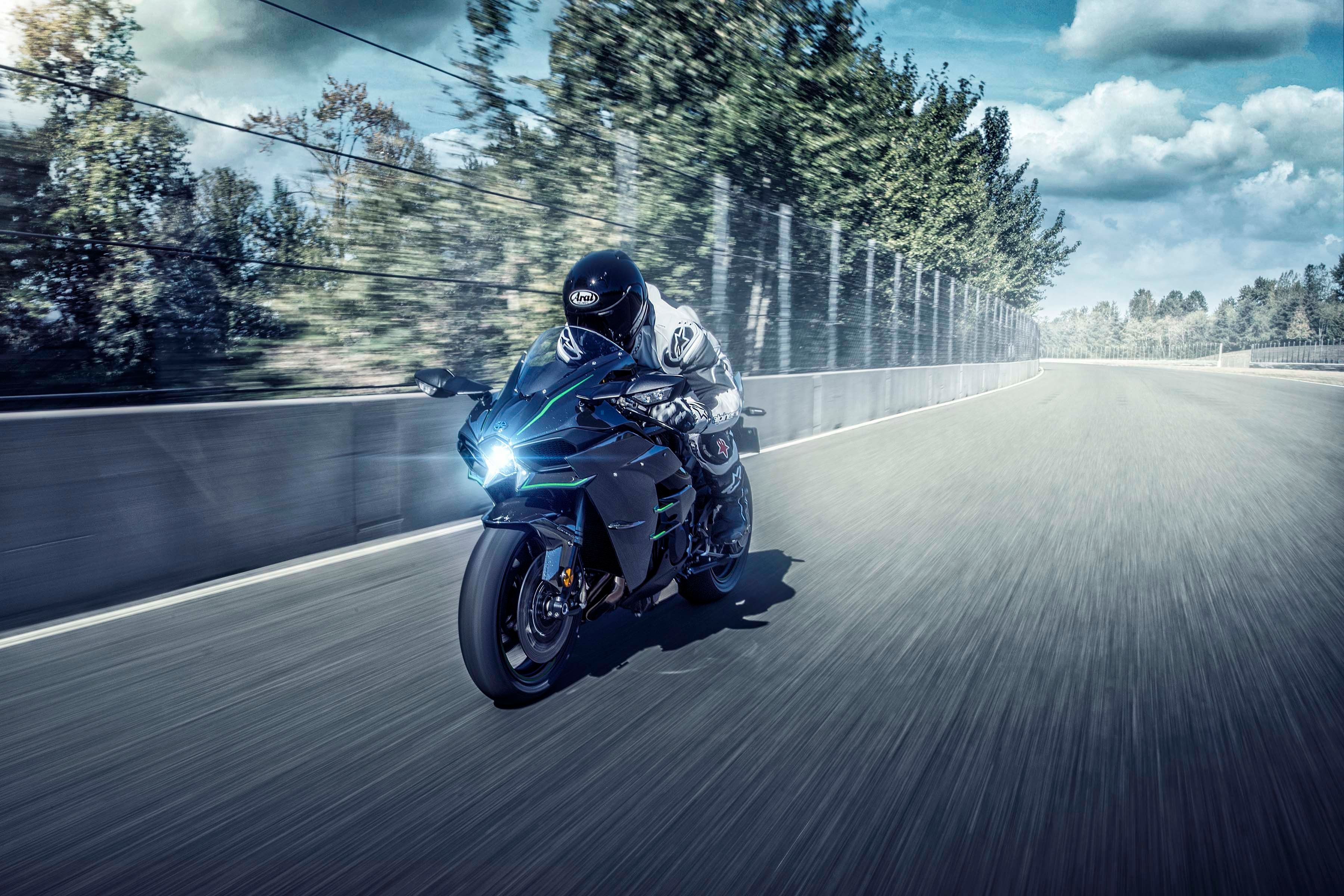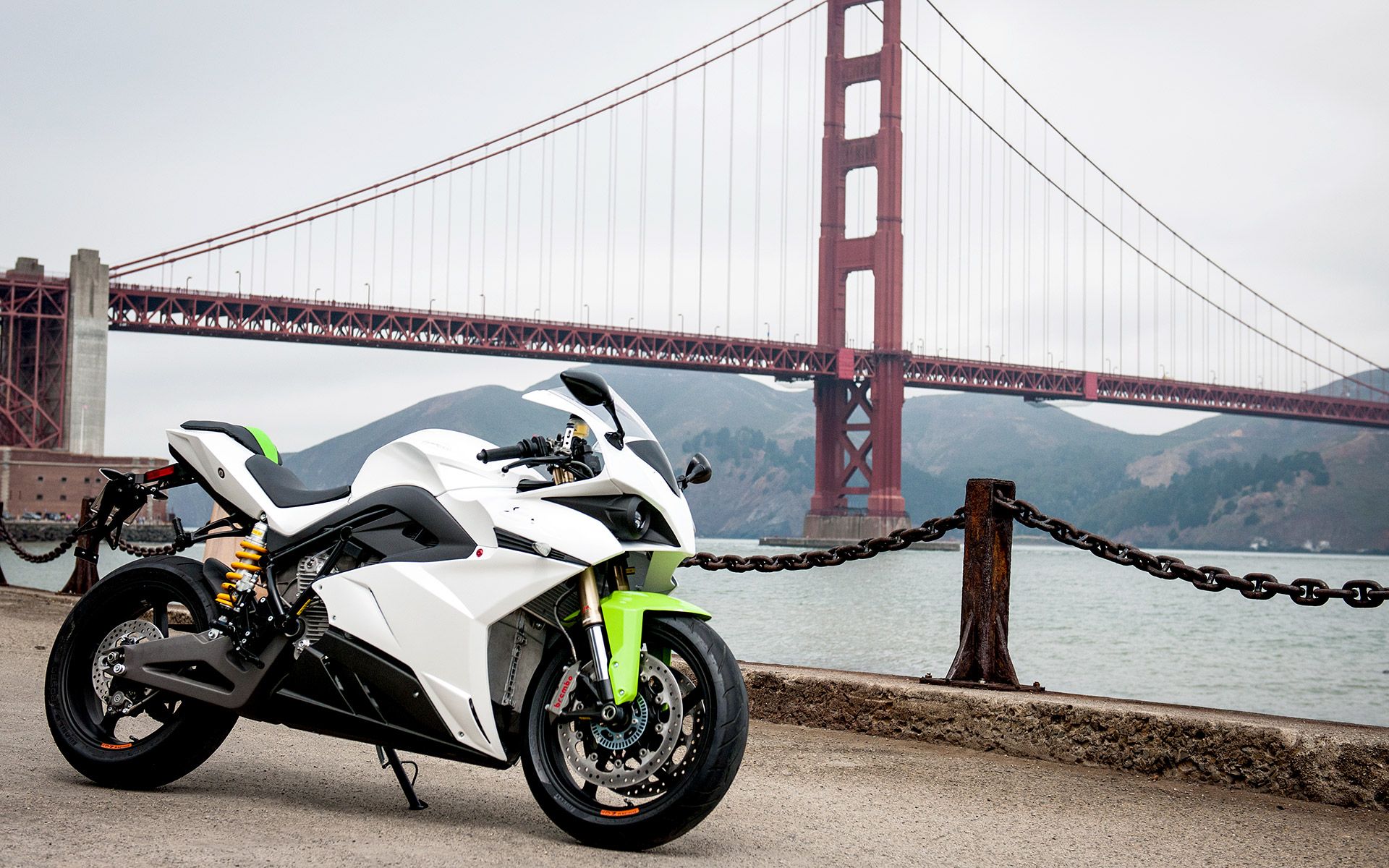In a world where outright horsepower and straight-line speed hold center stage, these machines have blazed the streets and have swept us off our feet in the most fashionable ways possible. Built for speed, acceleration, braking, and cornering, they come equipped with components from the industry’s best names to achieve a little more speed every single time they get on the paved asphalt.
With the emphasis of a sport bike being on performance, there are certain design elements that most motorcycles of this type will share. Rider ergonomics favor function. Apart form the high performing engines, they are built to cut through the air as smoothly as possible. High tech and expensive materials are often used on sport bikes to reduce weight.
Kawasaki Ninja 400
Starting off with this new lightweight Sportsbike from the Japanese Green Team, this ninja 400 replaces the existing Ninja 300 as the brand’s entry-level sportsbike having greater performance, better-structured chassis, better features, more rider aids, and top-quality fit and finish. It is also 8 kilos lighter.
The bodywork has been picked up from its elder siblings, the Ninja 650 in particular, and gets a ‘large-volume bodywork’ that offers better wind protection to the rider than the 300. It carries styling influences of the chin spoilers and the tail cowl from the mighty Ninja H2 along with the swingarm mounting plate and the lightweight steel trellis frame. It also shares the same instrument cluster with the Ninja 650, contributing to the high-grade feel of the package. As with modern times, the 400 gets all around LED treatment including headlamps and the taillights.
The newly built 399cc powerplant will pump out 45 hp of peak power compared to the 38 hp from the Ninja 300; thanks to the new downdraft intake and the larger airbox offering increased intake efficiency. The motor is similar in size to the Ninja 250 and 300 but is one kilogram lighter than the former even with the larger bore and stroke. The bike is sportier, more aggressive and more fun to ride than the lesser cubed Ninja. It gets a new Assist & Slipper clutch for effortless gear shifts, and aggressive downshifts without the rear wheel chatter.
The 41mm forks replace the 37mms’ used on the previous editions and are there to give the rider precise feel and action. The bike comes equipped with the latest ABS unit from Nissin, clamping down on a 310mm semi-floating disc (the largest in its class). Adding to the lightweight program is the 5-spoke wheels picked up from the 650 which gives improved lateral rigidity and cornering stability. The Ninja 400 also gets fatter rear rubber with 150/60R17 tire ratings.
At the bottom of the barrel is the base Ninja 400 in Metallic Spark Black or Candy Plasma Blue for $4,999. The same black theme can be had on the ABS model for $5,299. If you want that Pearl Solar Yellow/ Pearl Storm Grey/Ebony finish or the Lime Green/Ebony KRT version, Kawasaki will ask you to pay to the tune of $5,499. Buyers have a choice of warranty packages from which to choose.
MV Agusta F3 675 RC
The MV Agusta F3 675 RC is the hottest performing middleweight sportbike in production wearing civilian clothing. The bikes come in the perfect blend of performance and handling together with the graphically accurate duplicate of the factory racers as seen on this limited-edition RC (Reparto Corse) paint jobs. For 2018, the bike receives mild updates with their powertrain, electronics, and chassis to keep their mark on the ever-improving sportsbike market.
Being the most accessible sportsbike of the Schiranna house, the F3 borrows styling elements from its elder sibling, the flagship F4 superbike. It includes a race-spec titanium exhaust system complete with carbon fiber heel guard and aluminum silencer support brackets. For visual extravaganza, the kit will also include a fiberglass rear seat cowl, billet machined levers, rear sprocket for race track gearing, and as a proof of uniqueness, each RC will get its own certificate of origin.
MV created a unique three-cylinder engine that is regarded as the most advanced and powerful mid-sized power unit to have ever been built. Coming as a standard, the F3 675 RC will now feature a redesigned race-spec titanium exhaust system made by SC-Project, straight from the Racing Department. It bumps that power up to a phenomenal 133 hp at 14,750 rpm with a dedicated ECU mapping. Thanks to the new EAS 2.0 electronic shifter, it now allows for easier clutch action to operate the beasts like a breeze.
This chassis is coupled to adjustable USD 43 mm Marzocchi fork having 125 mm travel and fully adjustable Sachs mono-shock at the rear piggybacking a nitrogen reservoir. This job of braking is given to a Nissin radial pump operated Brembo monobloc radial calipers having twin 320 mm and 220 mm discs at the front and rear respectively. At the technology front, this bike is laden with top class electronics and rider aids that includes the MVICS (Motor & Vehicle Integrated Control System) platform getting new Ride-by-Wire with personal mappings and revised 8-level traction control, Rear Wheel Lift-Up Mitigation and Bosch 9 Plus ABS.
Limited to just 350 units, the 2018 F3 bikes get top-drawer kits to take the performance to astronomical heights. Although you can pick the F3 675 as it is at € 15,490 ($17,880), the RC edition will cost you € 18,990 ($21,920). It also gets a special Street and Racing graphics scheme along with the SC Project exhaust unit.
Ducati 939 SuperSport
Each and every motorcycle in the stable of Ducati speaks of some purpose which is beautifully blended with the pinch of hardcore passion. And so is Ducati’s Supersport series which has been developed to make sport riding comfortable and more practical for city riding. It is basically a Panigale with toned down feistiness and less of the maddening monster of a powerhouse, making it the most high-end practical motorcycles once can buy from the stable of Ducati.
In a stand or on the move, the SuperSport will be the best dressed amongst all the others in its class. The mean front fairing with sharp and angular dual headlamps continue to catch your attention, even after being a four-year-old face. Unlike the Panigale, the bodywork of the SuperSport brags the red trellis frame sneaking out. You also get a twin compact lateral silencer with two overlapping exits, which leaves the rear wheel with its “Y” spoke design, fully visible. Thanks to the single-sided swingarm.
Sharing the powertrain combination with the Ducati Hypermotard 939 and the Multistrada 950, the Supersports gets the same four stroke, liquid cooled, Testastretta, L-twin, Desmodromic 937cc engine. The Desmodromic EURO 4 engine is prancing with 113 bhp at 9000 rpm and 71.5 lb-ft of peak torque at 6500 rpm. It also makes use of an oil-bath slipper clutch that facilitates optimum rear wheel chatter during aggressive downshifting. This will allow the rider to take full advantage of the cutting-edge Ducati Quick Shift (DQS) up/down unit with auto-blipper.
The SuperSport is designed to do one thing. To offer a less aggressive and intense riding experience than the rest of the stablemates. For this reason, you get the high set clip ons and revised footpeg positioning to let you ride the bike more comfortable than any other sports bike in the segment. 48 mm TiN coated multi-adjustable Öhlins suspension set, and radial monoblock Brembo M4-32 calipers handle the braking and suspension. ABS, Traction control and riding modes come as standard.
The SuperSport is priced at $ 12,995, and the SuperSport S is going to be at $ 14,995. At this price, it is going to be a steal deal compared to the competition. You can get them in two colors of Ducati Red with Ducati Red frame and Matt Black wheels and Star White Silk fairing with Ducati Red frame and Glossy Red wheels.
Suzuki GSX-R 1000/R
Of all that we have, the 2001 entry kid GSX-R1000 is regarded as one of the most usable supersport bikes on sale in the two-wheeler market, which is tamable effectively by both the amateur as well as seasonal bikers. For this 6th generation, the folks at Suzuki are determined to restore the GSX-R1000 to its throne and become the top performing motorcycle to the world to see. It is touted to become the most compact, the most aerodynamic and the best-handling GSX-R 1000 ever.
All the models of Suzuki GSX-R1000 produced till date have always been in the middle ground concerning design – they may not have been as exotic as the European or the new Japanese mongers of liter class motorcycles, but that doesn’t mean they were monotonous machines. Same goes with the new Suzuki GSX-R1000 – it has a clinical design.
The 4-stroke, 4-cylinder, liquid-cooled, DOHC motor retains the same 999.8 cc capacity, but that is where the resemblance ends with the previous generations. For 2018, the engine belts out a 200 bhp @ 13200 rpm, and the peak torque it produced is 87 lb-ft @ 10800 rpm. The first instrument of this is the Suzuki Racing Variable Valve Timing (SR-VVT) system developed in MotoGP. The Suzuki Clutch Assist System (S-CAS) removes chatter during aggressive downshifts.
This GSX-R 1000 gets the top of the line equipment in terms of suspension and braking units. Apart from the mighty engine to lurch this monster ahead quickly, this motorcycle has a huge gambit in terms of the electronics package it carries. Starting with the MotoGP developed 6 axis IMU that controls the 32-bit dual processor ECM (Engine Control Module), Suzuki Drive Mode Selector (S-DMS), TCS (Traction Control System), Low RPM Assist, Suzuki Easy Start System, Launch Control and Bi-Directional Quick Shift System that allows the rider to upshift and downshift without using the clutch or the throttle.
The GSX-R1000 will be available for $ 14,599 (MSRP), and you get it in Metallic Triton Blue, Metallic Red, and Metallic Mat Black color. This is a good $ 700 more than the previous edition. Well, no complaints there looking at the amount of work Suzuki has gone into making this the King of Superbikes. The ABS edition will cost you $14,999 (MSRP), and you get it in Pearl Mira Red and Metallic Mat Black color.
Kawasaki Ninja ZX-10RR
Towards the end of 2016, Kawasaki surprised everyone with the much-awaited upgrade to its liter class supersport, the Ninja ZX-10RR. The motorcycle, which has always remained as one of the one of the most user-friendly and equally precise-to-use supersport in the world, received a thorough upgrade in each aspect, be its design, performance, mechanicals and set of electronics.
Apart from a minor cosmetic change which Kawasaki has carried out for the Ninja ZX-10RR, the basic powertrain of the motorcycle too has undergone a couple of small changes as well. On the new Ninja ZX-10RR, the overall engine and gearbox combination has been carried forward - the engine is the same four stroke, liquid cooled, inline four, 998cc engine, which pumps out 197 hp of power and 84 lb-ft of torque. With the help of ram air input, the power can be bumped up to 204 hp as well.
On the new Ninja ZX-10RR, the new revised frame and suspension combination of 43mm fully adjustable balance free telescopic forks at the front and a horizontal back-link with balance free gas charged mono shock at the rear has been lifted off from the standard Ninja ZX-10R. The brakes are same as well – dual 330mm Brembo discs at the front and a single 220mm disc at the rear.
As expected, the new Ninja ZX-10RR gets the same list of electronic aids as that of the Ninja ZX-10R, which includes ABS, Kawasaki Launch Control (KLCS), Kawasaki Intelligent Braking (KIBS), Kawasaki Sport Traction Control (S-KTRC), Kawasaki Engine Braking Control (KEBC) and Kawasaki Quickshifter (KQS). All of which work efficiently in making the riding as well as braking experience a bit more engaging in the part of the rider.
While Kawasaki has priced the Ninja ZX-10R starting at $15099 (MSRP), the ultimate liter class motorcycle from the Japanese Green, the 2017 Kawasaki Ninja ZX-10RR will cost at $18899 (MSRP). And only 500 of them will be made by Kawasaki. The Kawasaki Ninja ZX-10RR will be only available in Flat ebony color, and you can also get accessories and Race Kit parts to make your machine really yours.
Yamaha YZF-R1/M
Touted as the sharpest and most track-focused supersport bikes you could get your hands on, Yamaha has updated their mad YZF-R1 and YZF-R1M superbikes with recalibrated equipment and a couple of new features keeping the competition alive and well. The 2018 R1 series will enhance rider experience by improving suspension, shifting and fuelling to be the "most sought-after supersport motorcycles designed to deliver the pinnacle of performance on and off the track".
Most of the updates are mostly underneath the skin, which itself gets a new Team Yamaha Blue on the R1 and a Silver Blu Carbon paint job on the R1M. The new Yamaha R1 comes bolstered with the same liquid-cooled, parallel four-cylinder engine which oozes out 197 hp and 150 lb-ft of torque. The engine is coupled to a 6-speed gearbox with slick up-shifts on tap.
For 2018, the folks at Yamaha have given the Quick Shift System (QSS) an “auto-blip” downshift technology that can now accommodate clutchless downshifts along with the up-shifts. And the best part of it all, the rider can disengage the function through the Yamaha Ride Control (YRC) settings found in the newly updated TFT instrumentation.
Another electronic gadget present to aid the rider called the Lift Control System (LIF) also gets further refinements to prevent the front end from lifting off the ground during those hard acceleration scenarios. Thanks to the new Bridgestone RS10 tires, the rider now gets a better grip and feedback to hoon the track around.
The YZF-R1M has one another trick up its sleeve with the Öhlins Electronic Racing Suspension (ERS) getting updated with the latest Smart EC 2 ERS system. It can now be fine-tuned via the YRC settings using a smartphone app connected to the motorcycle’s Communication Control Unit (CCU). The YZF-R1 2018 edition will hit showroom floors in March at $16,699 while the limited-edition R1M will also come around the same time and cost you $22,999.
Ducati Panigale V4
Christened as the Panigale V4, Ducati calls it the ‘new symphony of all Italian performance and emotion.’ The V4 Panigale also comes in two special editions: The Panigale V4 S and the Panigale V4 Speciale. The V4 S gets everything from the standard V4 but gets kitted with a higher spec suspension setup like the Öhlins NIX-30 forks, Öhlins TTX 36 shock absorber, Öhlins steering damper with Öhlins Smart EC 2.0 system, aluminum forged wheels and Lithium-ion battery.
The limited edition (only 1500 units) Panigale V4 Speciale ups the ante even higher than the V4 S with a "Speciale" colour scheme, Carbon fibre front/rear mudguards, identification number on a solid machined plate, Alcantara seats, dedicated handle grips, adjustable foot pegs, carbon fiber heel guard and cover swinging arm, racing articulated levers, brake level protection, race spec Akrapovic exhaust system, racing screen, Ducati Data Analyser+ GPS (DDA + GPS), Racing fuel tank cap and mirror replacement plugs.
Powering this will be the brand’s most technologically sophisticated and compact power-plant ever created that is believed to annihilate anything in the liter class superbike segment. The crazy new ‘Desmosedici Stradale’ 1103cc plant screams at the top of its voice at 14000 rpm and pumps out a mighty 214 hp at 13000 rpm. Add the all-titanium Akrapovič racing exhaust, and you can boost the power to 226 hp.
Controlling the rise and fall from the massive acceleration and baking will be the 43mm Showa Big Piston Fork (BPF) at the front and fully adjustable Sachs shock at the rear. A Sachs steering damper completes the front-end package. New lightweight Brembo Stylema monobloc calipers are the evolution of the M50 and handle the decelerations pretty well. Debuting here are the controlled drift during braking and ABS Cornering on the front wheel which takes into account lean angles and optimizes corner exit performance. Other packages included on this V4 are three new Riding Modes (Race, Sport and Street), Ducati Traction Control EVO (DTC EVO), Ducati Slide Control (DSC), Ducati Wheelie Control EVO (DWC EVO), Ducati Power Launch (DPL), Ducati Quick Shift up/down EVO (DQS EVO), Engine Brake Control EVO (EBC EVO) and Ducati Electronic Suspension EVO (DES EVO).
Usually, you might expect the price to act as a firewall to keep weapons such as these out of the hands of ordinary mortals, but such is not the case with the V4 family. The base model starts out at $21,195 while the mid-grade V4 S carries a $27,495 sticker. At the top, the Speciale goes for $39,995, but if you’re looking at a racebike, price probably isn’t an issue.
Aprilia RSV4 RF LE
Called as the Aprilia RSV4 RF LE (RF Limited Edition), the carbon fiber winglets on this will change the way future superbikes will look like. Underpinned by the legendary RSV4 architecture, the new machine will be a limited edition affair of just 125 units, and all of them are heading to North America.
The special livery seen here is a salute to the first world championship win in 1987 by Loris Reggiani on his AF1 250GP, which is also on the current MotoGP RS-GP prototypes. You also get the “Limited Edition” logo and the unit number laser inscribed on the steering yolk plate, and forged aluminum rims come as a standard option. The color TFT instrumentation tethered to the advanced V4-MP multimedia platform transforms your smartphone into a semi-professional “virtual” dashboard instrumentation.
The Limited Edition affair will be underpinned by the same potent four stroke, liquid cooled, V-4, 999.6cc engine with its 65° angle between the banks that made an exceptional chassis architecture to work around with. The 4-stroke, liquid-cooled mill prances with a whopping 201 hp at an exhilarating 13,000 rpm and peaks the torque map at 82.8 lb-ft coming at 10,500 rpm. This four-cylinder mill comes mated to a 6-speed gearbox, which gets the assistance of Aprilia Quick Shift Electronic System (AQS) and a slipper clutch mechanism.
The RSV4 RF receives an Aluminium dual beam chassis, Ohlins NIX forks and TIX shocks and an adjustable steering damper, Monoblock M50 Brembo units with “Race ABS” Bosch 9MP adjustable to 3 map settings. Rear wheel Lift-up Mitigation, Traction Control, Wheelie Control, Launch Control, cruise control and speed limiter, all of which can be configured and deactivated independently suitable to the three riding maps: Track, Sport and Race.
You also get the “Limited Edition” logo and the unit number laser inscribed on the steering plate. It will become available for $24,499. The RSV4 RF LE bikes will come in limited numbers of 100 units to North America (25 to Canada).
Kawasaki Ninja H2 / H2 Carbon
Co-developed by Kawasaki’s motorcycle and aerospace division, this ‘world’s only’ supercharged hyper sports motorcycle got every purist into a realm of more content and less bitter ever since it was launched in 2015. The H2 is an elegant artwork of supreme violence making 207 hp, more power than any of the superbikes in competition then.
Only Kawasaki’s breed of imaginative designers could have turned a blank design canvas into the H2. That design, even though is more than a couple of years old, still manages to shock and awe every brain in that skull of mine. All due to be given for its signature silver mirror paint job and sci-fi looks, to its electric green trellis frame and Ninja star wheels. The ‘Carbon edition’ gets every raceboy’s favorite carbon panel feature limited only to the front fairings.
What sets the H2 apart from every other two-wheeler in production is the 998cc supercharged engine churning out a massive 207 hp @ 11000rpm. With strong lower and midrange power delivery, the acceleration only keeps increasing all the way up to 14000 rpm redline because of its 100 lb-ft torque. The transmission has a 6-speed dog ring system found on MotoGP bikes.
To add a little more control and bling, the H2 gets Ohlins TTX shock offering more support and ride quality with 22 adjustment settings for every breed of riders. Updated linkage ratios apparently also improve its track manners. Dual semi-floating 330 mm Brembo discs 4 piston calipers do the job quite brilliantly with the help of ABS.
Electronic rider aids include the advanced 6-axis IMU (Inertial Measurement Unit) system, updated KTRC (Kawasaki Traction Control) and KIBS (Kawasaki Intelligent Anti-Lock Braking System) that hopefully prevents you getting dangerously out of control. A 3 step KLCM (Kawasaki Launch Control Mode) will prevent wheel spin and minimize wheelies off the line. The quick shifter is now also enabled as an auto-blipper for coming seamlessly back down through the gearbox.
The H2 models will cost you $28,000 for the Standard H2, while the H2 Carbon would come with a $31,000 price tag. The 2018 Ninja H2 is available in Mirror Coated Spark Black, while the 2018 Ninja H2 Carbon is offered in Mirror Coated Matte Spark Black / Golden Blazed Green with its clear coated raw carbon fiber fairing on display.
Energica Ego
The final and most interesting entry in our list is this all-electric sports machine that shows just how viable electric bikes can be, at least as far as raw performance goes. In fact, this battery-powered adrenaline mill could give many dino-juice sportsbike a run for their money – as long as it was a short race, anyway.
The Ego is pure sportsbike, and the full body panels even tipple it toward the superbike range, a trend that extends to the performance envelope. The lines of the Ego design would not look out of place in any group of sportsbike, be they Japanese or European in origin. Standing still, only the cooling fins visible behind the engine shroud and unusual swingarm/shock setup give it away as not just another sportsbike, making this a good option for those interested in a “green” ride without necessarily announcing it to the world.
A permanent-magnet AC (PMAC) electric motor provides the drive. It cranks out 136 ponies from 4,900 through 10,500 rpm where the rev limiter kicks in, and a soul-crushing 143.8 pound-feet of torque from zero to 4,700. The battery rated for 1200 cycles can take charge in 3.5-hours or less, as low as 30 minutes for an 85-percent charge depending on the level of discharge and which of the four charging modes you use. Charge time and range are the hot-button topics on electric vehicles of any sort, and the Ego gives up around 93 miles at an average speed of 49 mph, which is fine for around town, but you can forget about any kind of road trips at high speed.
Marzocchi provides the ride at the front end, with 43 mm USD forks that come with adjustments for compression and rebound damping, as well as preload. A coil-over Bitubo monoshock acts directly on the radical swingarm sans linkage, and it too comes with adjustable rebound damping and spring preload. Brembo four-pot calipers bind the massive 330 mm front brake discs, and a twin pot Brembo grabs the 240 mm disc in back. The braking forces are moderated by the Bosch switchable ABS that also comes with a nifty anti-rear-wheel lift up function.
U.S. buyers can expect to drop around 34 grand on an Ego if last year’s prices are any indication, and it comes in Matte Pearl White or Matte Black, both with some really green highlights.

